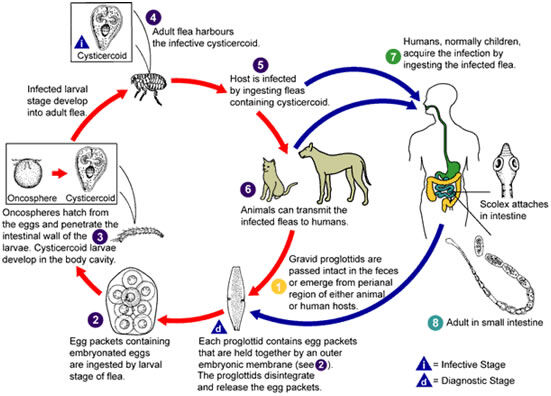Essentials of Diagnosis
- Motile proglottids 23 by 8 mm.
- Proglottids have genital pores at either end and contain egg clusters.
- Eggs occur in compartmented clusters (diagnostic).
- Scolex has 4-7 rows of hooklets and 4 suckers.
General Considerations
D caninum is distributed worldwide and is associated with wild and domesticated cats and dogs. The life cycle is similar to that of H diminuta, with an obligatory arthropod intermediate host. The adult worm lives in dogs, cats, or humans, and gravid proglottids are released from the adult worm either singly or in short chains. Eggs are passed in the stool, and ingestion of eggs by the intermediate host results in the development of the larval form within the arthropod host. Ingestion of the arthropod that contains larvae results in the development of an adult worm in dogs, cats, or humans. Adult worms may reach 10-80 cm in length.
Dipylidium caninum is a parasite that affects dogs and cats worldwide, including in the UK. While human infections are rare, they can occur, particularly in young children who may accidentally ingest infected fleas. Tapeworms, including Dipylidium caninum, remain common parasites among UK cats and dogs despite widespread use of anthelmintics by pet owners. The presence of these parasites often causes distress to pet owners due to their visible segments, which resemble grains of rice or cucumber seeds. Although infections in humans are rare, they have been reported globally, including in the UK. Here is the article about tapeworms in the UK.
Clinical Findings
Signs and Symptoms
Infection with D caninum is not commonly associated with clinical symptoms, although indigestion or anorexia may be present. Also anal pruritus has been reported.
Laboratory Findings
Microscopic stool examination will frequently reveal characteristic egg clusters and proglottids. As with other cestode infections, blood examination may demonstrate mild leukocytosis with eosinophilia.
Differential Diagnosis
Since D caninum infection in humans is often asymptomatic, most patients do not seek medical care. Once eggs are found in the stool, the appearance of egg clusters is so characteristic that no other parasite could be confused with D caninum. When a patient does seek the care of a physician for indigestion or anorexia, a variety of gastric pathologies need to be ruled out (eg, peptic ulcer disease and gastric outlet obstruction).
Complications
No complications are associated with D caninum infection.
Treatment
Therapy for D caninum infection is niclosamide in a one-time dose (see Box 87-2).
In the UK, the treatment of choice for Dipylidium caninum infection in pets is praziquantel, an anthelmintic that is highly effective against this tapeworm. Regular deworming of pets is recommended, especially for those that hunt or have had recent flea infestations.
Prognosis
The prognosis for D caninum infections is excellent.
Prevention & Control
Infection with D caninum can be reduced by screening domestic dog and cat stools and treating pets found to be infected (Box 3).
Controlling ectoparasites, such as fleas, is crucial in preventing tapeworm infections, as fleas serve as intermediate hosts for the parasite. Pet owners are advised to consult with their veterinarians to establish an appropriate deworming and flea control regimen tailored to their pet’s lifestyle.
While human infections with Dipylidium caninum are uncommon in the UK, maintaining good hygiene practices is essential to minimize risk. Regular handwashing after handling pets, prompt disposal of pet feces, and effective flea control measures can significantly reduce the likelihood of transmission. Educating pet owners about the life cycle of the flea tapeworm and the importance of controlling flea infestations can aid in preventing both animal and human infections.


